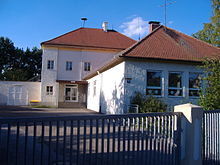Hundszell
|
Hundszell
City of Ingolstadt
Coordinates: 48 ° 43 ′ 43 " N , 11 ° 24 ′ 22" E
|
|
|---|---|
| Height : | 366-371 m |
| Area : | 2.33 km² |
| Residents : | 1783 (December 31, 2017) |
| Population density : | 765 inhabitants / km² |
| Postal code : | 85051 |
| Area code : | 0841 |
|
Location of Hundszell in Ingolstadt
|
|

Hundszell is a district and sub-district of Ingolstadt , with the Hundszell sub-district, in addition to the district of the same name, also including the village of Schmalzbuckel , the Knoglersfreude settlement , the hamlet of Samholz and the Herrenschwaige .
Extension and location
The subdistrict Hundszell is located in the city district southwest and has an area of 233.7 hectares, whereby it is bordered in the west-northwest by the foothills of the Danube floodplains . The neighboring districts are Haunwöhr in the northeast , Unsernherrn in the extreme east and Spitalhof, Oberbrunnenreuth and Hagau in the south.
history
Hundszell was first mentioned in a document as Hundscelle at the beginning of the 13th century, making it the oldest of the Ingolstadt Audörfer. According to further documents from the years 1245, 1265 and 1303, the lords of Hundsberg, a knight family, resided there. The manor probably also included a small church, the foundation of which may go back to the Münchsmünster monastery . In 1319 Ludwig the Bavarian donated the estate to the Heilig-Geist-Spital Ingolstadt. For the year 1463 the tax books already show 21 taxable properties. In the description of the Ingolstadt Rent Office by Philipp Apian from 1563 Hundszell is not mentioned. It is also not shown on the land boards. This suggests that the importance of what was once the third largest place in the truce of Ingolstadt on the threshold of the early modern era has lost its importance. There are also no remains of the medieval manor so far.
Hundszell was spun off from Ingolstadt in 1813 and was part of the Ingolstadt district for 100 years from 1862 . During this time Hundszell belonged to the Unsernherrn community . On January 1, 1962, part of the Unsernherrn community with Hundszell was reclassified to Ingolstadt. Especially in the late 1980s and early 1990s, the place expanded.
population
2386 people lived in Hundszell with their main residence (as of December 31, 2006). In 1987 Hundszell had 1,027 inhabitants and in 1997 already 2,129 inhabitants. The proportion of under 18-year-olds in Hundszell is 24.9% and thus well above the Ingolstadt average. The population density is 1021 inhabitants per square kilometer, just above the Ingolstadt average.
religion
59.5 percent of the Hundszellers are Catholic , 22.5 percent Protestant and 18.0 percent belong to other denominations or religions or are not confessional.
The construction of the church in Hundszell , which is dedicated to the Immaculate Conception of Mary, was considered as early as 1894. The foundation stone for the neo-baroque Marienkirche was laid on March 17, 1912. On October 19, 1914, the consecration Monday in 1914, the new church was designated by Dean Schröder “in the presence of 3 priests and with great sympathy from the people”. The inauguration took place 20 years later. It was not until Sunday, September 30, 1934, that the church was inaugurated by Bishop Konrad Graf von Preysing . In 1953 the Catholic parish Herz Jesu was established in Ingolstadt. So that the church foundation has the required size, the Haunwöhr parish, which was previously part of the Hundszell church foundation, was allocated to it. At the same time, the parish Herz Jesu took over the supply of the Hundszell Church Foundation, since the pastor of Our Lord was no longer able to guarantee the supply. It was not until August 28, 1967 that the Hundszell Church Foundation officially became part of the parish of the Sacred Heart of Jesus.
Economy and Infrastructure
Hundszell consists mainly of residential areas . Only on Kirchstrasse and Lechermannstrasse are there a few service companies , such as electrical retailers, driving schools or butchers. There is also a garden market and a sanitary facility.
traffic
For private traffic, Kirchstrasse, Lechermannstrasse and Hagauerstrasse are the most important connection options. In local public transport, Hundszell can be reached via the buses 10 and 45, as well as the night line N15 of the Ingolstädter Verkehrsgesellschaft . There are a total of nine bus stops in the subdistrict .
education
The only school in Hundszell is the elementary school, which is part of the Haunwöhr elementary school and in which only grades 1 and 2 are taught. In 1995 the Ingolstadt Farm Equipment Museum was opened in Hundszell. In a former farm , the topics of agriculture , cattle breeding and rural transport are dealt with in 3 departments . It also houses a forge and a bakery .
Sports
In 1971, Hundszell's sports club with the largest number of members was founded, SV Hundszell. Its departments include soccer and stick shooting.
Individual evidence
- ^ Wilhelm Volkert (ed.): Handbook of Bavarian offices, communities and courts 1799–1980 . CH Beck, Munich 1983, ISBN 3-406-09669-7 , p. 601 .
literature
- Rassa, Kurt: City and District of Ingolstadt , Munich: 1963, pp. 22–24.
- Hans Fegert: Ingolstadt districts - the history of Hundszell. Kösching 2005.
Web links
- Donaukurier: via Hundszell.
- SV Hundszell: Sports club.



